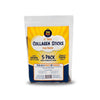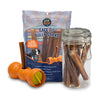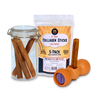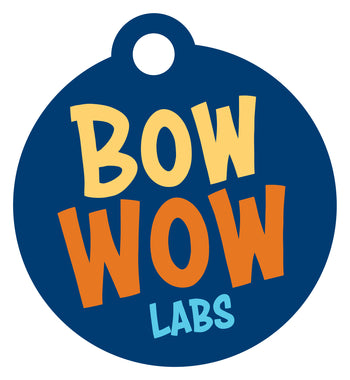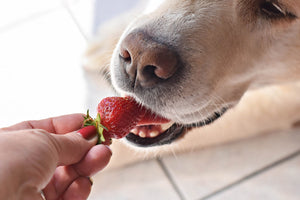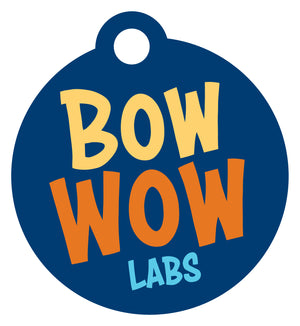You may have heard people say, “I never give my dog people food!” Well, let’s turn this around and talk about what this means. While you should never feed your dog onions, grapes, raisins, macadamia nuts and chocolate (these are TOXIC foods and should always be avoided), feeding “people food” can actually be highly beneficial.

Of course, we don’t suggest adding spicy leftovers or seasoned table scraps. This is less about sharing your meal, letting them lick the plate or eat your pizza crust. Rather, it's about intentionally adding fresh, nourishing food to support your dog’s health.
So now that we’ve gotten that squared away, here are five highly beneficial foods you can start adding to your dog’s bowl to improve their overall health.
1. Eggs: One of the most nutritious foods on the planet, packed with protein, fats, vitamins and minerals. Eggs contain all the essential amino acids a dog needs and are highly bioavailable and digestible, meaning your pup’s body doesn’t have to work hard to absorb these nutrients! Eggs from pasture-raised, free-range chickens are the most nutritious, and if you can get them from your neighbor or local farmer, even better. At about 70 calories per egg, you can easily feed your dog a hard-boiled, sunny-side-up or scrambled egg (use olive oil sparingly when cooking without seasoning). They'll love it.
2. Green bananas: Yep, we said green, not yellow! This is due to the high sugar content in yellow bananas, which is much lower in unripe (green) ones. In fact, a green banana is not only tasty but also a great source of resistant starch that helps support the gut microbiome. Green bananas are also a source of antioxidants and have some anti-inflammatory properties.
One medium green banana is approximately 105 calories, so cut it into small sections and use between 1/8th to 1/4 of a banana per serving, depending on your dog's size. Can’t get through a green banana quickly enough before it ripens? Studies show that freezing them does not impact the resistant starch and can increase their vitamin C and fiber content.1
3. Berries: Blueberries, strawberries, raspberries and blackberries are high in antioxidants. Antioxidants help reduce free radicals, the compounds that, if out of balance, lead to oxidative stress in the body. These beautiful little gems are a tasty treat and best served organic, whenever possible to reduce exposure from herbicides, like glyphosate. If feeding strawberries, be sure to remove the stem and leaves as these may cause digestive upset. Frozen berries also pack a powerful nutrient punch and are easy to get year-round. At only 2–5 calories per berry, you can add them without worry to your dog’s waistline, but if you feed too many, their stools may temporarily change color, especially with blueberries or blackberries.
4. Broccoli & broccoli sprouts: Your kids may not eat it, but most dogs enjoy these cruciferous veggies. Broccoli is an amazing “superfood” that helps support liver detoxification because of its high sulfur-containing compounds. When broccoli (or its sprouts) is chopped or chewed, an enzyme* is released that converts specific compounds into resulting sulforaphane. This isothiocyanate has been well-documented for its liver protective and detox properties.2 Broccoli sprouts have the highest sulforaphane content and are easy to grow on your windowsill from organic seeds. Because of their low-caloric content, you don’t need to worry about calories here, but too much broccoli can cause gas and bloating, so a little goes a long way.
*The myrosinase enzyme is deactivated through high-temp cooking preparations, which reduces sulforaphane, so feed raw or lightly steam for the highest benefit.3
5. Cranberries: While not for super finicky dogs, a simple chop and mix into your dog’s bowl can provide antioxidants and support urinary tract health. In fact, cranberries contain proanthocyanadins (also known as PACs), which are polyphenols recognized for their anti-inflammatory properties. However, the real power of these PACs lies in their ability to prevent bacteria from adhering to the bladder wall. So if you have a dog prone to urinary tract infections, these are a great preventative addition (they will not help an active infection).4 Cranberries also offer vitamin C, which may provide additional immune support, but keep in mind that dogs produce vitamin C naturally in their liver, and this is not an essential nutrient.
To be clear, we aren’t talking about cranberries with sugar or artificial sweeteners; we are talking about the ones you get in a bag around Thanksgiving (and yes, with the holiday coming up, you can stock up and freeze them). Ideally, you would only offer cranberries a few times a week and dogs don’t need many. Small dogs can get 2–3, medium dogs 4–5 and large dogs 6–7. Remember, cranberries are tart, so this is not something your dog will likely take as a treat. The best bet is chopping them up, adding them to their bowl and mixing them thoroughly.
Adding even a few of these fresh, nutrient-dense foods to your dog’s bowl can make a big difference over time. Be sure that any additions (including the foods mentioned above, treats and chews) do not make up more than 10% of your dog’s caloric intake to avoid causing nutrient imbalances. Introduce new foods gradually and if you have a dog with any dietary condition, consult your veterinarian first. And remember, even though these people foods can be beneficial, they are meant to supplement your pup’s diet and should never replace complete and balanced foods.
Johnna Devereaux is a Clinical Pet Nutritionist, canine wellness expert and Chief Nutrition Officer for Bow Wow Labs.
* This article is for informational purposes only. It is not, nor is it intended to be, a substitute for professional medical or veterinary advice, diagnosis, or treatment and should never be relied upon or perceived as specific medical or veterinary advice.
**The points of view expressed above are those of our clinical nutritionist and are supported by science, her education and experience. We are committed to providing the best, most straightforward, and most helpful information possible to help keep your dog happy, healthy and safe.
References:
- Munir H, Alam H, Nadeem MT, Almalki RS, Arshad MS, Suleria HAR. Green banana resistant starch: A promising potential as functional ingredient against certain maladies. Food Sci Nutr. 2024;12(6):3787-3805. doi:10.1002/fsn3.4063
- Anonymous. Sulforaphane Shown to Enhance Detoxification Gene Expression. Designs for Health. January 12, 2021. Accessed August 10, 2025. https://www.casi.org/node/1350
- Zhang T, Holman J, McKinstry D, et al. A steamed broccoli sprout diet preparation that reduces colitis via the gut microbiota. J Nutr Biochem. 2023;112:109215. doi:10.1016/j.jnutbio.2022.109215
- Chou HI, Chen KS, Wang HC, Lee WM. Effects of cranberry extract on prevention of urinary tract infection in dogs and on adhesion of Escherichia coli to Madin-Darby canine kidney cells. Published online April 1, 2016. doi:10.2460/ajvr.77.4.421




